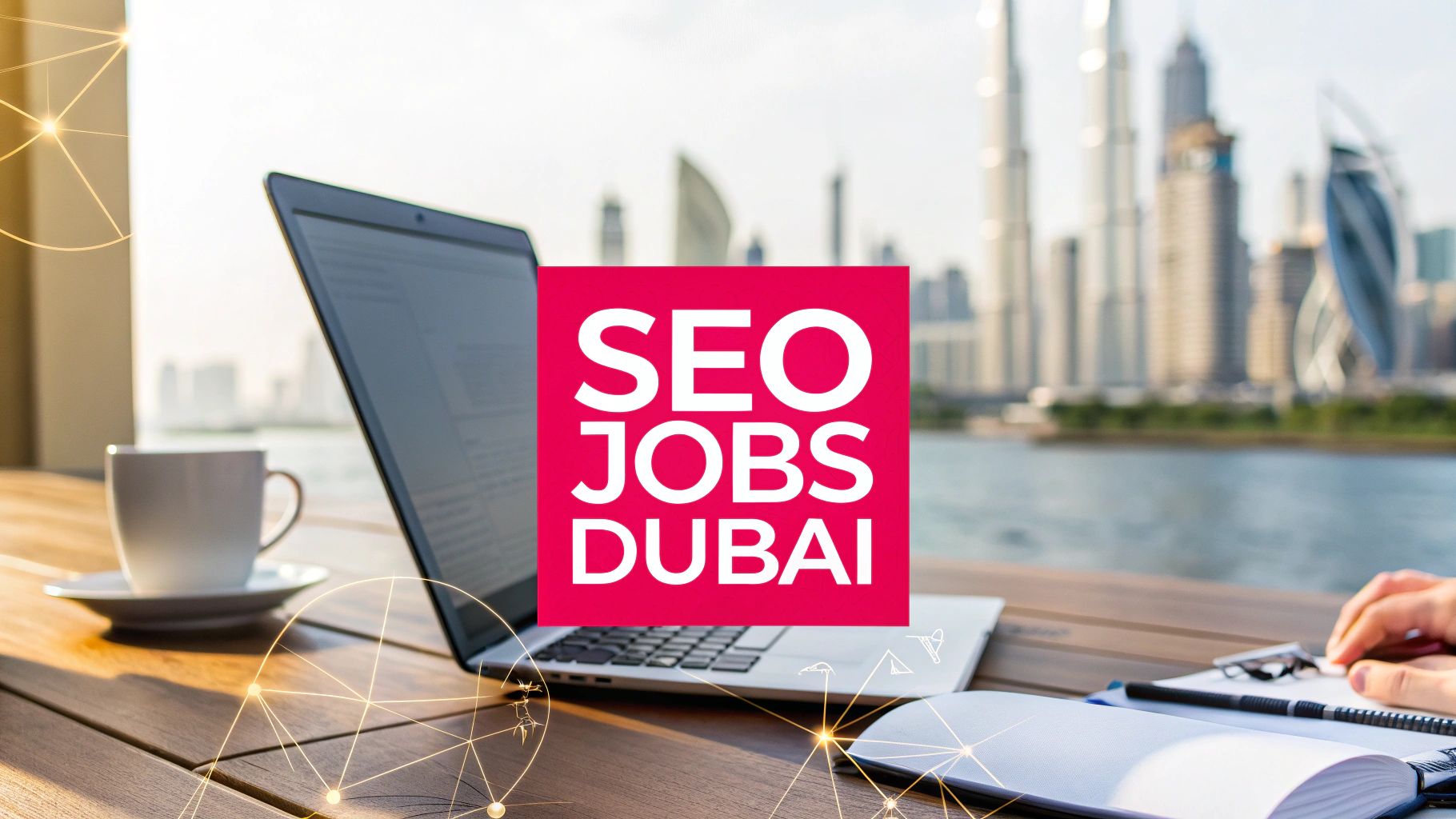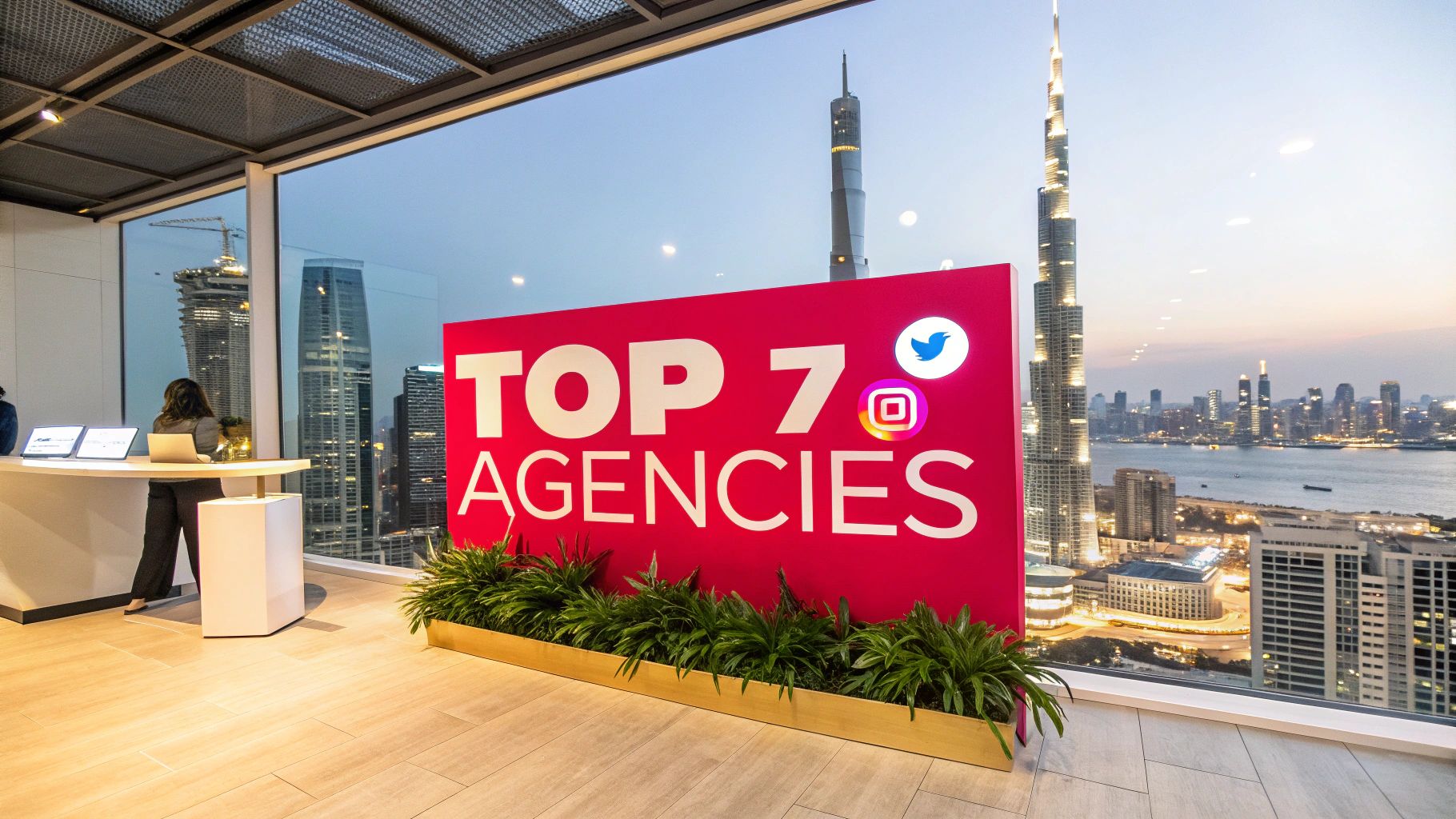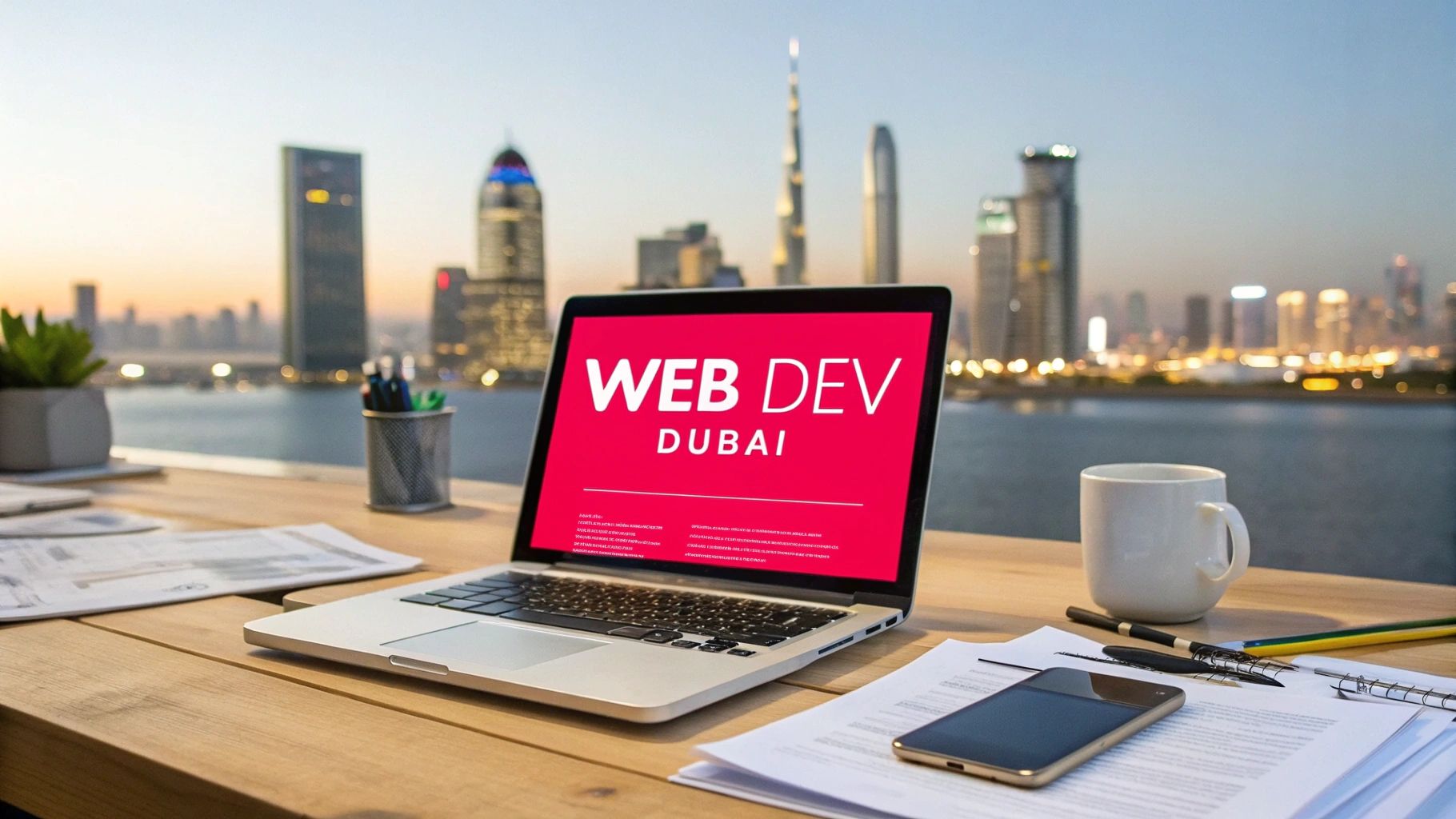Before you even think about design or code, let's get one thing straight. A successful Dubai ecommerce business is built on a solid foundation of smart strategy, not just a pretty storefront. It all starts with getting under the skin of the local market, figuring out how people shop here, and sorting out the legal stuff from the get-go.
Building Your Foundation for a Dubai Ecommerce Store
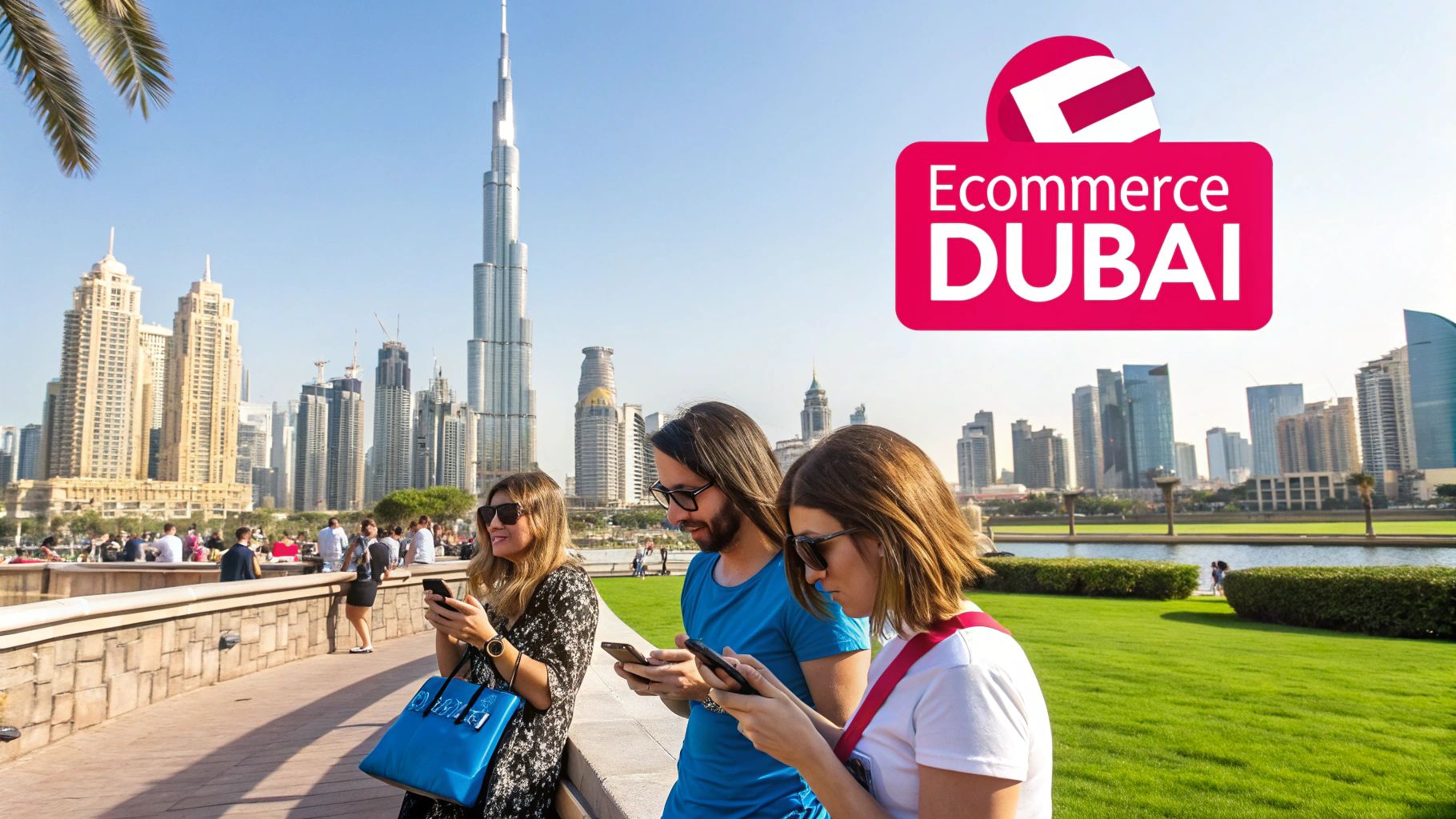
Jumping into Dubai’s vibrant online marketplace is about more than having a great product. It requires a solid plan and a genuine feel for how things work locally. The potential here is massive. The UAE's ecommerce market hit a value of USD 11.01 billion in 2023 and is on track to more than double, reaching an estimated USD 23.62 billion by 2032. What's driving this? A highly connected population with over 99% internet penetration and a serious love for smartphones.
This initial groundwork is critical. It’s where you transform a business idea into a concrete, workable plan, setting yourself up for success long before you spend a single dirham on development.
Conducting Meaningful Market Research
Your first move? Look past the big numbers and pinpoint your specific niche. Don't just guess what will sell; prove it. Spend time seriously analysing what your direct competitors in Dubai are up to. What are they great at? And more importantly, where are they dropping the ball?
- Spot the Gaps: Search for customer needs that aren't being fully met. Is there a hunger for sustainable fashion, specialised electronics, or locally made artisanal goods that no one is catering to properly?
- Analyse Competitor Websites: Go through the user experience of the top local ecommerce players. Take notes on everything: their site navigation, how smooth their checkout is, and whether their site works well on a phone. A huge part of your own success will come down to a well-thought-out ecommerce website design UAE.
- Understand Shopper Habits: Dubai’s customers are a unique mix of Emiratis and expats, each with different expectations. They crave speed, trust, and above all, convenience. Things like offering cash on delivery (COD) and having a crystal-clear returns policy can make a world of difference in earning their trust.
Expert Insight: Real market research isn’t about finding data to support your brilliant idea. It’s about discovering what the market actually wants and then figuring out how your business can deliver that better than anyone else.
Navigating Legal and Licensing Requirements
You simply cannot afford to ignore Dubai's regulatory environment for online businesses. One of the absolute first steps is understanding the process for obtaining an ecommerce license. Depending on your specific business activity and nationality, you might need an E-Trader license from the Department of Economic Development (DED) or a more comprehensive ecommerce trade license.
Trying to skip this step can lead to hefty fines or even getting your operations shut down, so make it a priority. It does more than just keep you out of trouble; it makes your business legitimate in the eyes of customers and, crucially, payment gateway providers. Proper legal standing is the bedrock of any lasting ecommerce business in the region.
Choosing Your Ecommerce Platform for the UAE
Picking the right technology for your online store is one of those foundational decisions that will shape everything from your day-to-day work to your future growth. Your platform isn't just a piece of software; it's the digital backbone of your business. That's why, for any ecommerce website development in Dubai, you need to look past a simple feature list and think about how it will actually perform in the local market.
The opportunity in Dubai's ecommerce scene is massive, and it's only getting bigger. The data really paints a picture of just how much potential there is.
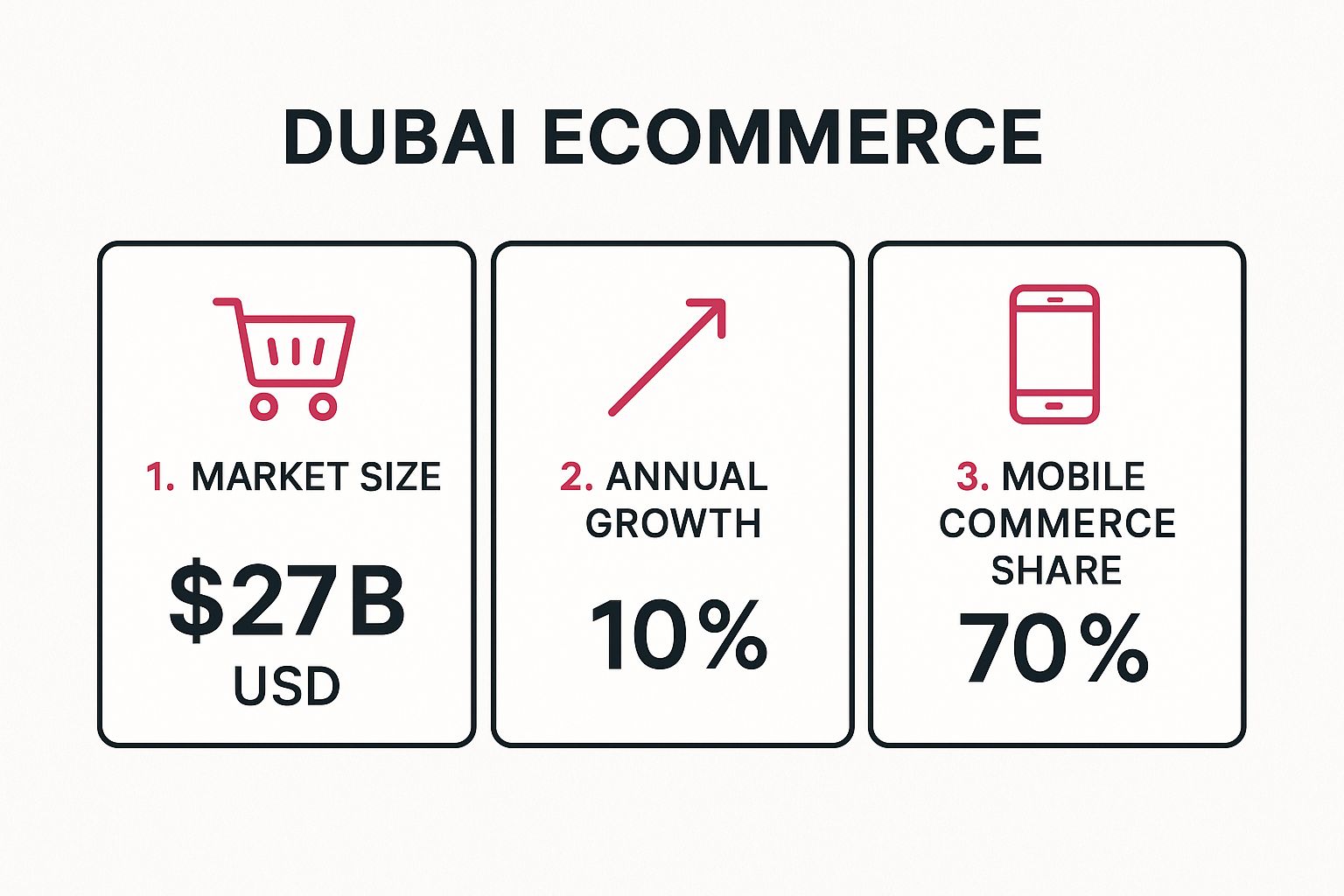
These aren't just numbers; they represent a huge, engaged, and mobile-first customer base. This makes it absolutely critical to choose a platform that can handle serious traffic and provide a flawless experience on smartphones.
Matching the Platform to Your Business Model
There’s no "one-size-fits-all" answer here. The best way to choose your tech stack is to let your business model lead the way.
-
For a Startup Fashion Brand: If you're launching a new fashion label, your top priorities are likely speed and simplicity. This is where a platform like Shopify really shines. Its user-friendly interface means you can get a beautiful, professional-looking site live in no time, often without hiring a developer. Plus, its huge app store makes it easy to plug in local payment gateways and courier services.
-
For a Specialised Electronics Retailer: Selling electronics often requires more than just a "buy now" button. You need detailed specifications, product comparison tools, and in-depth content. This calls for flexibility, which is where WooCommerce comes in. As a plugin for WordPress, it’s open-source, giving you total freedom to customise the user experience. You'll need to manage your own hosting and security, but for that, you get complete control over your data and site design.
-
For a Large Enterprise with Complex Needs: What about an established retailer with a massive inventory, multiple physical locations, and sky-high transaction volumes? This is enterprise territory, and it demands a powerhouse solution like Magento (now Adobe Commerce). It's built for scale, offering incredible customisation, multi-store management, and advanced features for both B2B and B2C sales. The investment is significantly higher, but for a large-scale operation, its ability to grow is second to none.
Key Takeaway: Forget searching for the "best" platform. The right platform is the one that fits your budget, technical skills, business needs, and future plans.
Comparing Top Ecommerce Platforms for Dubai Businesses
To help you visualise the trade-offs, here’s a quick comparison of the three major players based on what matters most for a business in Dubai.
| Feature | Shopify | WooCommerce (WordPress) | Magento (Adobe Commerce) |
|---|---|---|---|
| Best For | Startups, SMEs, businesses wanting ease-of-use | Businesses needing high customisation on a budget, content-heavy sites | Large enterprises, B2B businesses, high-volume stores with complex needs |
| Ease of Use | Very high. Intuitive and beginner-friendly. | Moderate. Requires some technical knowledge of WordPress. | Low. Requires expert developers for setup and maintenance. |
| Localisation for UAE | Good, via apps for local payment gateways (Telr, PayFort) and shipping. | Excellent. Highly customisable to integrate any local service directly. | Excellent. Built for complex, multi-regional setups. |
| Scalability | Good for most businesses, with Shopify Plus for enterprise-level needs. | Good, but depends heavily on your hosting and optimisation. | Unmatched. Designed for massive scale and high transaction volumes. |
| Total Cost of Ownership | Moderate. Monthly subscription + transaction fees + app costs. | Low to High. No subscription fee, but costs for hosting, plugins, and development. | High. Significant investment in licensing, development, and hosting required. |
This table gives you a starting point. Your final decision should come after carefully weighing these factors against your specific business goals and resources.
The Critical Factors You Can't Ignore
As you evaluate your options for ecommerce website development in Dubai, keep these three things at the top of your list:
-
Localisation and Integration: This is non-negotiable. How easily can the platform connect with UAE-specific payment gateways like Telr or PayFort? Can you integrate it with local couriers like Aramex for live shipping rates? Look for platforms with native support or at least proven, reliable apps for these essential services.
-
Scalability: Think about your business in two or three years. Will your platform be able to handle a surge in traffic during a sale? Can it manage a growing catalogue of products without slowing down? You need a solution that can grow with you, not hold you back.
-
Total Cost of Ownership: The sticker price is just the beginning. You need to calculate the total cost, which includes hosting, essential apps or plugins, transaction fees, and ongoing maintenance. An open-source option might seem cheaper upfront, but developer and maintenance costs can quickly add up.
The UAE’s ecommerce ecosystem is incredibly dynamic, with over 36,900 online stores competing for customers. The apparel sector is the most crowded, with 6,520 stores. What's truly telling is that major enterprise platforms like Salesforce Commerce Cloud are driving a huge chunk of the revenue. This shows the market's maturity and the fact that serious players are investing in robust, scalable technology.
If you want to dive deeper, you can find more insights on regional ecommerce statistics to see how the market is broken down. It’s clear that choosing a capable platform isn’t just a technical decision—it’s a strategic one that’s crucial for grabbing a meaningful share of this market.
Designing a User Experience That Resonates in Dubai
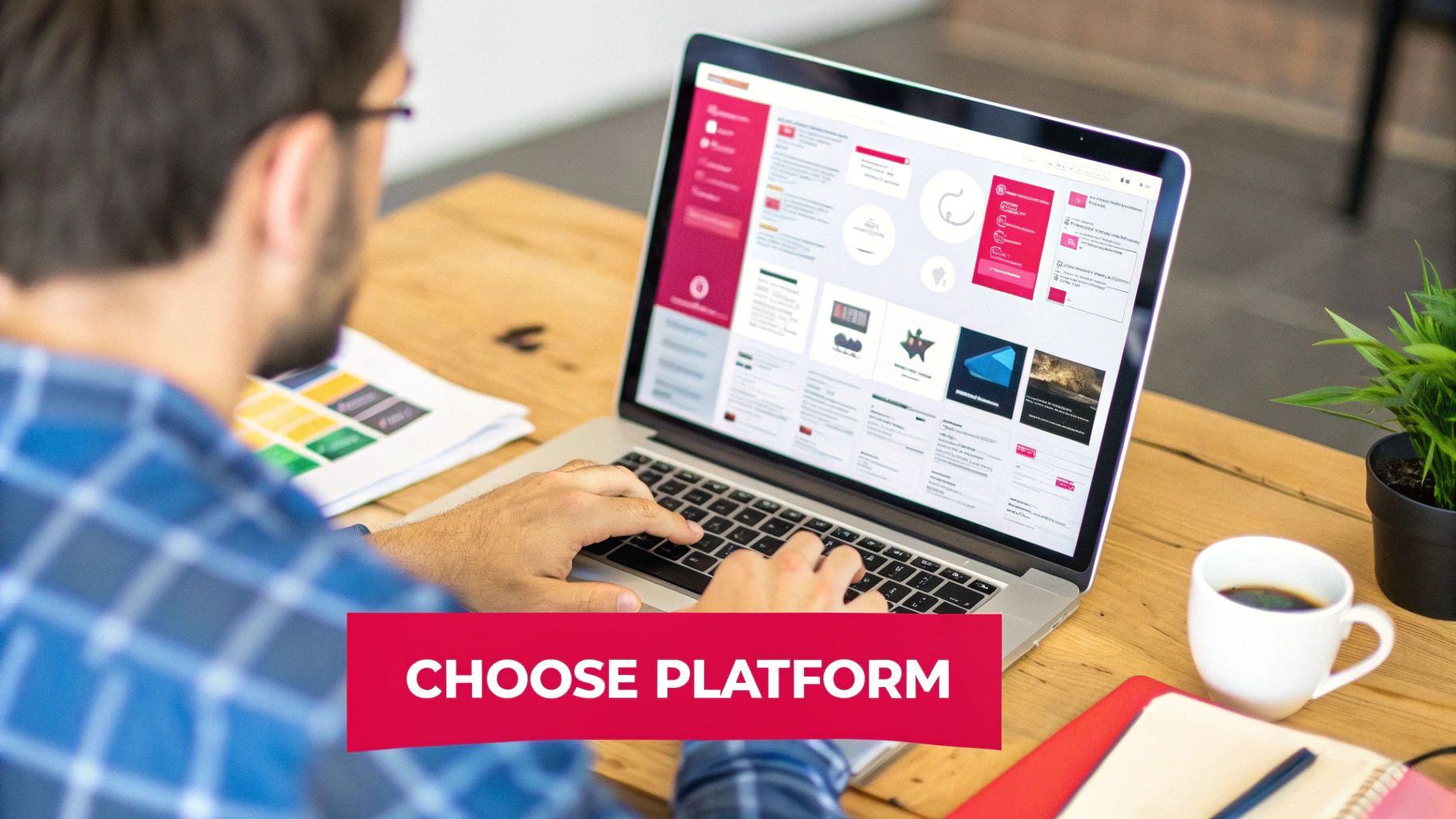
To build a successful ecommerce site in Dubai, you have to speak the local language—and I don't just mean the text on the page. True success comes from a design and user experience (UX) that shows a real understanding of the region's cultural fabric. It's a critical piece of the puzzle that, frankly, too many businesses get wrong.
Flipping a switch for Arabic language and showing prices in AED is just table stakes. You have to weave cultural awareness into the very soul of your website, from the photos you select to the flow of your navigation.
Visuals That Create a Connection
Your site's imagery is the first handshake with a potential customer. It can either forge an instant bond or create an immediate sense of "this isn't for me."
-
Authentic Representation: Ditch the generic stock photos that look like they could be from anywhere. Instead, use visuals that respectfully and genuinely show life in the UAE. Think local landmarks, a diverse mix of models that reflect the actual population, or product shots set in a context that feels familiar.
-
Modesty and Respect: This is a big one. Pay close attention to cultural sensitivities. All your imagery, especially of people, must be modest and align with local customs. Getting this right shows you’ve done your homework and builds a foundation of trust.
-
Colour Psychology: Colours have powerful cultural associations. While Dubai's aesthetic can be bold and vibrant, it helps to understand the local context. Green, for instance, is deeply significant in Islam and often associated with prosperity.
Building an Intuitive User Journey
Beyond the look and feel, the way your site is structured has to make sense for a varied audience of locals and expats. If people can't find what they're looking for, they won't buy it. Simple as that.
Key Insight: A confusing website is the digital version of a messy, disorganised shop. Shoppers in Dubai expect speed and convenience. If they can’t find a product in a few clicks, they’re gone—and they won't be back.
This is especially true when it comes to the checkout. Keep your forms clean and ask only for what's absolutely necessary. Be upfront about all costs, including shipping and any duties, right from the beginning. No one likes a nasty surprise at the final step, and it's a guaranteed way to increase abandoned carts.
Adopting a Mobile-First Mentality
Mobile commerce in the UAE isn't a growing trend; it's the default way people shop. A massive percentage of online sales are completed on smartphones, which means a mobile-first design isn't optional—it's essential for survival.
Your site can't just be "mobile-responsive." It needs to be designed from the ground up with the mobile user in mind.
- Thumb-Friendly Navigation: Make sure all your buttons and links are big enough to be tapped easily with a thumb. No frustratingly tiny links.
- Optimised for Speed: Mobile users have even less patience for slow-loading pages. Compress your images and clean up your code so your site loads in a flash.
- Painless Checkout: The checkout flow should be incredibly smooth on a small screen, requiring as little typing as possible.
When you put these culturally-aware design principles at the forefront, you create an online shop that feels welcoming, trustworthy, and incredibly easy to use. That's how you turn first-time visitors into repeat customers.
Getting Payments and Deliveries Right in Dubai

Let's be honest: a stunning website is just the beginning. The real heart of your e-commerce operation beats in the background. It's the smooth, almost invisible process of a customer paying for their order and receiving it on time. This is where you truly win or lose in Dubai's crowded market. Get it wrong, and customers simply won't return.
The stakes are high, but so is the opportunity. The UAE's e-commerce market is valued at roughly USD 79.94 billion in 2024, and it's on a blistering trajectory to hit nearly USD 270.5 billion by 2032. This incredible growth is fueled by people who are comfortable paying online, making your backend setup absolutely critical.
Picking Your Payment Partners
The name of the game is making checkout feel effortless and completely secure. For shoppers in Dubai, this means seeing payment options they already know and trust.
- Telr: This is a solid, go-to option for many businesses, from startups to established players. It’s known for being relatively easy to set up and covering all the essential payment methods.
- PayFort (an Amazon Company): If you have ambitions to scale, PayFort is a regional heavyweight. It offers deep customisation, top-tier fraud protection, and handles multiple currencies with ease.
A word from experience: Don't even think about launching without Cash on Delivery (COD). I’ve seen businesses stumble because they assumed everyone pays by card. A huge chunk of the market here still prefers to pay when the product is in their hands. It's a trust signal, and skipping it will cost you sales.
Nailing Your Logistics and Delivery
The moment a customer clicks "Buy Now," a timer starts. Fast, reliable delivery is no longer a luxury—it's the standard expectation. Partnering with a solid local courier is one of the most important decisions you'll make for your ecommerce website development in Dubai.
You've got great options, from legacy giants like Aramex to agile, tech-first services like Fetchr. The best fit depends on things like how many orders you're shipping, how fast you need them delivered, and your budget.
Here's what you need to have sorted:
- Define Your Delivery Zones: Be crystal clear about where you deliver. Are you sticking to Dubai for now? Covering all Emirates? Shipping internationally? Your customers need to know upfront.
- Get Shipping Rates Right: Nobody likes a surprise shipping fee at the final step. Your website must pull accurate, real-time rates from your courier. This prevents cart abandonment and builds trust.
- Streamline Order Fulfilment: Whether you’re packing boxes in a back room or outsourcing to a fulfilment centre, the process has to be a well-oiled machine. A slow dispatch is a quick way to get a bad review.
And for those looking to appeal to a more tech-savvy audience, it might be worth exploring newer payment avenues. Thinking about the future of payments often leads to finding the best crypto payment gateway. While it's not a must-have for everyone just yet, offering it can set you apart as a forward-thinking brand.
Optimising Your Store for a Powerful Launch
Let's be blunt: a fantastic website is completely useless if your customers can't find it. The most successful launches I've seen are built on a solid foundation of Search Engine Optimisation (SEO) that’s woven into the development process from the very beginning, not just tacked on at the end. For any business serious about ecommerce website development in Dubai, this means you have to start thinking like a search engine from day one.
This isn't just about flicking a few switches before you go live. It's a strategic mindset that ensures your store is visible, fast, and ready to turn visitors into customers the moment you open your digital doors. Skipping this phase is like opening a beautiful, high-end shop on a street with no name.
Embedding Local SEO from the Start
Your first job is to dominate the local Dubai market. This goes way beyond just sticking "Dubai" in your website's footer. It's about getting inside the heads of your target audience and understanding exactly how they search for products like yours.
- Local Keyword Research: You need to pinpoint the specific Arabic and English phrases your customers are actually typing into Google. Are they looking for "luxury perfume delivery Dubai" or is it "buy authentic oud online UAE"? Tools like Ahrefs and SEMrush are brilliant for uncovering these high-intent local keywords.
- On-Page Optimisation: Once you have your keyword list, work them naturally into your meta titles, product descriptions, and category pages. A great, search-friendly product description does two jobs at once—it persuades both your customers and the search engines.
- Google Business Profile: Honestly, an optimised Google Business Profile is non-negotiable for local visibility. Get your details perfect and start encouraging customer reviews as soon as you can. It builds instant trust and significantly boosts your local search rankings.
Key Insight: Great SEO isn't about trying to trick Google. It's about making it incredibly easy for search engines to understand what you sell and why you're the best choice for customers in Dubai. This sweet spot where user needs meet technical setup is the heart of a winning strategy.
Critical Technical SEO Checks
Before you even dream of hitting that launch button, your website's technical health has to be absolutely perfect. Think of these elements as the invisible engine powering your store's performance and search rankings. A slow or insecure site is a massive red flag for both your visitors and Google.
A strong technical base often requires a bigger conversation about your overall growth and market position. Many businesses find this is where a holistic view of their online presence becomes crucial, which is why we often discuss the benefits of digital transformation consulting to make sure every part of the business is aligned for success.
For your Dubai ecommerce store to truly take off, it needs to be easily found. Beyond the initial setup, implementing proven strategies to improve website visibility is essential for long-term growth and making sure you don't get lost in the crowd.
Your Pre-Launch Readiness Checklist
Finally, a meticulous pre-launch check helps you avoid any embarrassing—and costly—hiccups on day one. Go through this list step-by-step:
- Mobile-First, Always: With most Dubai shoppers on their phones, you have to test your site's experience on various devices. It must be lightning-fast and dead simple to navigate on a small screen.
- Page Speed Obsession: Use Google's PageSpeed Insights to check your loading times. Every millisecond counts. Compress your images, minify your code, and make sure your hosting plan can handle the traffic. A site that loads in under 3 seconds sees dramatically better engagement.
- Lock it Down with SSL: An SSL certificate is essential, period. It encrypts data, protects your customers, and is a confirmed ranking factor for Google.
- The Full Checkout Test: Don't just pretend to buy something—actually do it. Run multiple test orders. Check every single payment gateway, shipping option, and confirmation email to guarantee the entire process is completely seamless.
- Analytics and Tracking: Make sure Google Analytics and any other tracking pixels (like for Meta ads) are installed and firing correctly. You can't improve what you don't measure.
Common Questions About Dubai Ecommerce Development
It's natural to have questions when you're setting up an online store in a new region. Getting the right answers from the get-go can save you a world of headaches and money down the line. Let's tackle some of the most frequent queries we get about building an ecommerce website right here in Dubai.
What’s the Real Cost of an Ecommerce Website in Dubai?
This is probably the most common question, and honestly, the answer is "it depends." The cost of building an ecommerce site in Dubai can swing wildly depending on what you actually need.
If you’re just starting out, a clean, simple store on a platform like Shopify can get you up and running for a few thousand dirhams. It’s a fantastic starting point for small businesses. On the other hand, if you're looking for a completely custom-built powerhouse on Magento or a unique B2B portal with complex integrations, you could be looking at an investment anywhere from AED 50,000 to well over AED 200,000.
Key Takeaway: Think of your budget as a direct reflection of your business goals. The final price tag comes down to the platform you choose, the amount of custom design work, and any special features you need.
Do I Really Need a Licence to Sell Online in Dubai?
Yes, absolutely. This isn't something you can skip. To operate legally, you must have the correct licence. The one you need will depend on your company structure and even your nationality.
For UAE or GCC nationals running a small-scale operation from home, the E-Trader Licence from the Department of Economic Development (DED) is often all you need. For everyone else—foreign nationals, larger companies, or businesses holding physical stock—a full ecommerce trade licence is mandatory. You’ll typically get this by setting up in a free zone or as a mainland company.
Which Payment Gateway is Best for the UAE?
There’s no single "best" option, but a few stand out as trusted leaders in the region. The right choice for your business will hinge on your expected sales volume, your website platform, and the features you prioritise.
- Telr: A very popular and reliable choice. It's known for being straightforward to integrate, which makes it a great all-rounder for many businesses.
- PayFort (an Amazon Company): This is a regional giant, perfect if you have big plans for growth. It offers top-notch security and supports multiple currencies.
- Stripe: A global favourite that has made a real name for itself in the UAE. Developers love it for its clean APIs and easy-to-use tools.
Don’t forget about Cash on Delivery (COD)! It's still a huge preference for many customers here, so most successful stores offer it alongside other gateways. Deciding which options give you the best rates and your customers the smoothest experience takes some thought. Strong data analysis for your marketing can reveal exactly what your customers prefer, ensuring you offer the right payment methods, not just a long list of them.
Ready to build an online store that not only looks great but is built on a smart, data-supported strategy? At Grassroots Creative Agency, we specialise in creating ecommerce experiences that drive real results. Let's build your digital future together.


